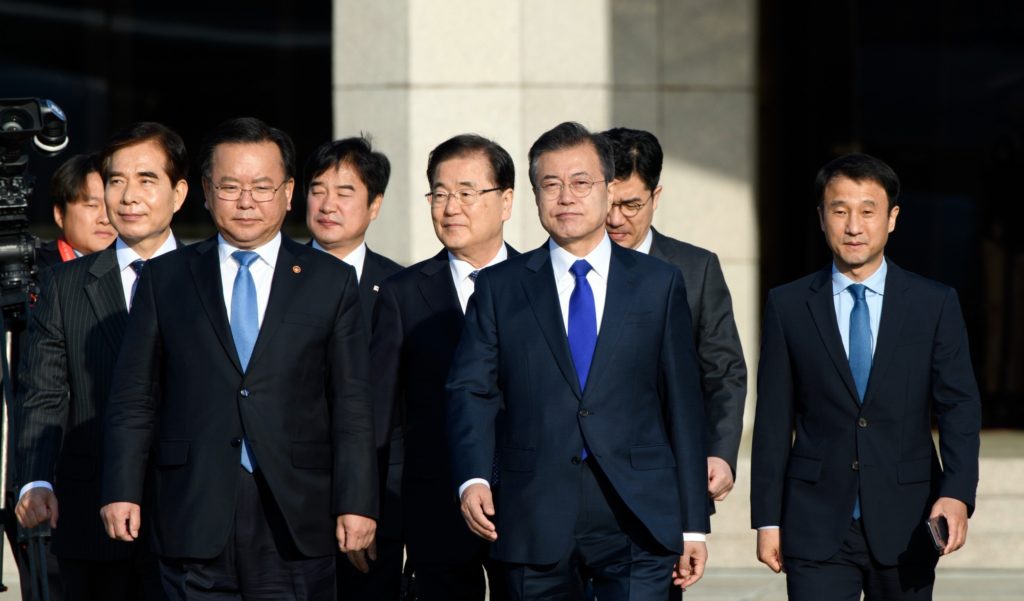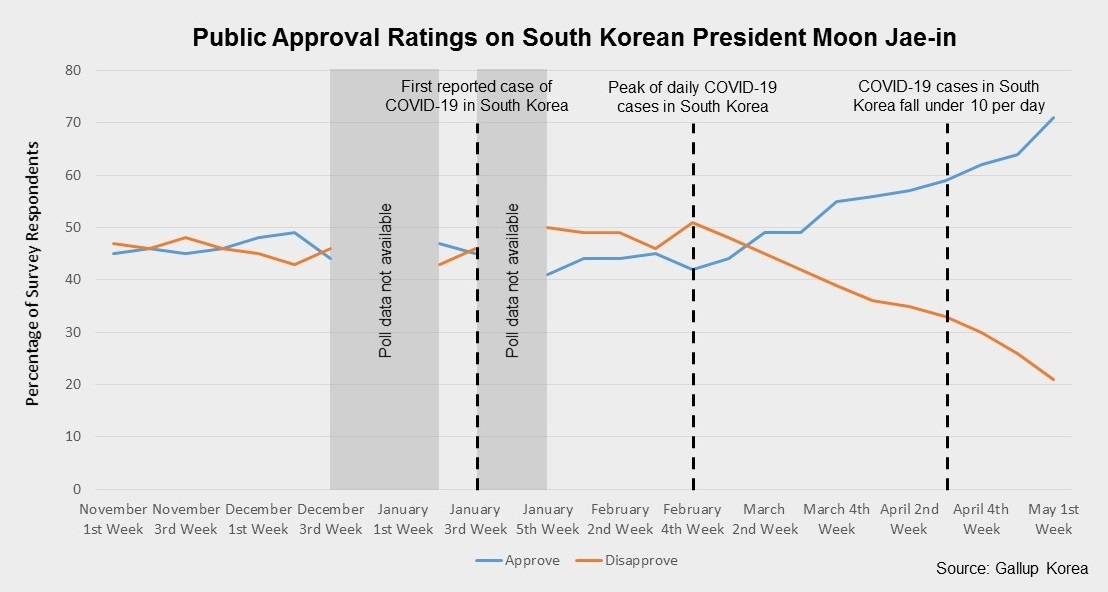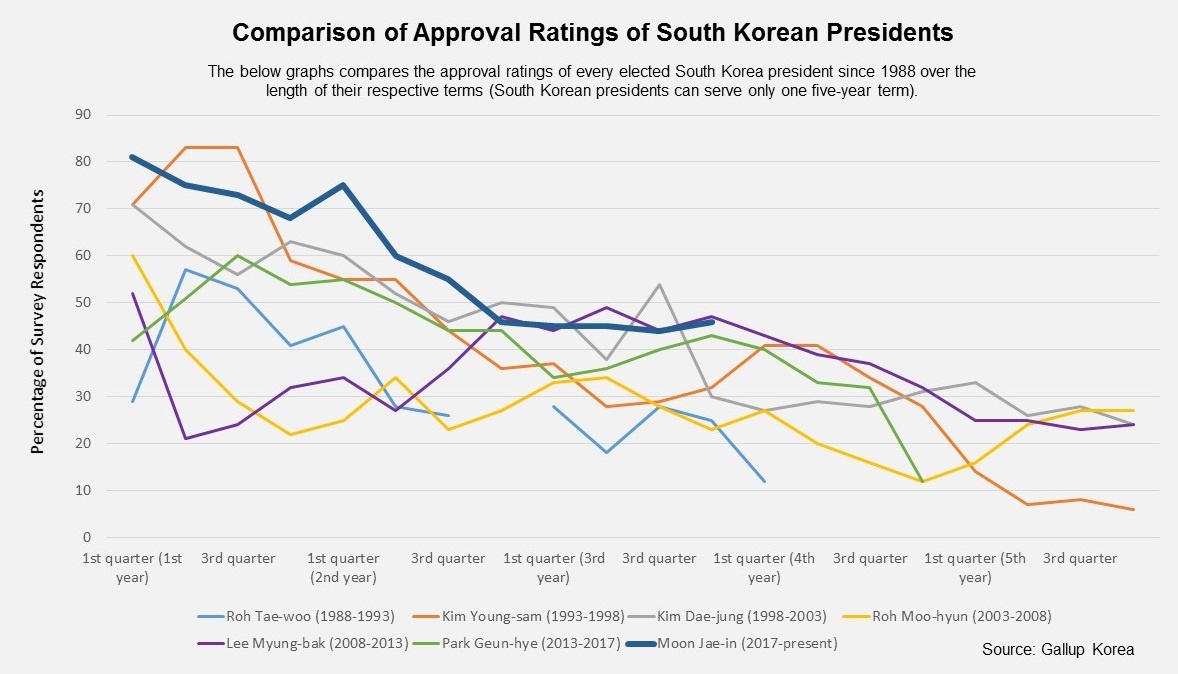The Peninsula
Moon Jae-in’s Approval Rating Soars on COVID-19 Response

By Juni Kim
After three years in office, President Moon Jae-in finds himself in uncharted, positive territory. No prior South Korean president has maintained an approval rating above 50 percent entering the fourth year of his or her term, but Moon for the past three weeks has seen his approval ratings rise past 60 percent according to polls conducted by Gallup Korea and Realmeter, with Gallup Korea’s poll last week indicating approval at 71 percent.
The Moon administration’s deft handling of the COVID-19 outbreak in South Korea has jumpstarted his previously diminishing approval numbers. At the initial outbreak of the COVID-19 crisis in South Korea in late January, Moon’s approval ratings were fluctuating at the low-to-mid 40 percent range. However, Moon has since made significant and steady gains among the South Korean public as his government’s efforts to contain the outbreak have so far been effective. In the latest Gallup Korea poll conducted on May 6th and 7th, 53 percent of respondents that approved of Moon indicated that the president’s handling of COVID-19 contributed to their positive response.

Moon’s public approval resurgence is remarkable on multiple levels. Moon had entered office with the highest approval ratings of any South Korean president in 2017 with over 80 percent approval, but as economic concerns increased and his efforts to engage with North Korea stalled, Moon’s ratings steadily declined before flattening below 50 percent throughout much of 2019. A political scandal last Fall involving the resignation of his controversial Justice Minister Cho Kuk saw his approval rating sink to as low as 39 percent. Beyond a bump in his approval ratings in early 2018 caused primarily by his diplomatic breakthroughs with North Korea, Moon did not have a significant increase in his approval ratings until March 2020. Moon’s recent successes in winning back public support were underscored by a historic voter turnout in parliamentary elections last month, which led to his party winning a supermajority in the National Assembly.
Moon is also bucking the historical trend of South Korean presidents that have generally seen their approval ratings drop throughout their five-year terms. Up until his recent surge, it seemed that Moon’s struggle to maintain his public support would not be too dissimilar from his predecessors. As mentioned previously, no previous South Korean president since 1988 has maintained an approval rating above 50 percent past their third year in office, and if Moon’s positive polling numbers continue he will become the first president to do so.

Even among other world leaders who have received public approval bumps due to their handling of COVID-19, Moon’s approval ratings rank among the highest. The polling firm Morning Consult tracked an average public approval gain of 9 percent among ten world leaders since the World Health Organization declared the COVID-19 crisis a pandemic on March 11th. In comparison with the Gallup Korea poll numbers, Moon received a 22 percent approval bump during that time, with only Australian Prime Minister Morrison (32 percent) and Canadian Prime Minister Justin Trudeau receiving a similar increase (22 percent). The bounce may be attributed to a “rally-round-the-flag” effect that some leaders have received during national crises. It should be noted that of the countries included in the analysis South Korea and Australia have had the most success in reducing the number of daily COVID-19 cases with numbers dropping below 20 cases per day for the past three weeks.

Despite the recent increase in public support, the unpredictable nature of the COVID-19 crisis will likely complicate Moon’s path forward for the remainder of his term. Reports of a new outbreak in Seoul’s Itaewon district renewed fears of the virus and underscored the difficulties of managing a crisis that may stretch into years. The economic effects caused by COVID-19 and the Moon administration’s handling of their fallout will also play a significant factor in his approval ratings. Moon’s approval had previously sunk due to economic concerns, and this may happen again with disconcerting signs of slowing growth and trade. And of course, there is the continuing puzzle of what to do about Kim Jong-un and North Korea. For his part, Moon remains undaunted in hoping to engage with North Korea. On May 10, he reiterated his hope for future cooperation on inter-Korean projects.
For now, Moon is in a strong position that has predecessors would have envied. With a supermajority in South Korea’s legislature and public support, Moon has political maneuvering room for the remaining two years of his five-year term. The COVID-19 crisis will continue to evolve and bring new challenges to his administration, but for now, Moon Jae-in appears far from being a lame duck.
Juni Kim is the Senior Manager for Operations and Technology at the Korea Economic Institute of America (KEI). The views expressed here are the author’s alone.
Graphics by Juni Kim.
Photo from the Republic of Korea’s photostream on flickr Creative Commons.
